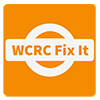Public roads in Washtenaw County are located on either an easement or deed interest in real estate, both of which are commonly referred to as the right of way. These strips or corridors of real estate intersect to create our road network. The right of way varies in width; a typical rural right-of-way is sixty-six (66’) feet wide whereas the urban primary roads typically have a width of one hundred twenty (120’) feet wide or greater.
Road rights-of-way are necessary for the operation, maintenance, and construction of our public roads. State law allows public utilities, including water/sewer, electricity, gas and telecommunication companies, etc. to locate their facilities within the public right-of-way under permit from the Washtenaw County Road Commission (WCRC). The shared use of the right-of-way can become congested and create conflict when non-permitted work is done without first obtaining a permit.
Any work proposed within the public road right-of-way, whether by an individual, property owner, or utility requires a permit. Examples of commonly permitted activities by residents include adding a driveway, replacing a culvert, modifying drainage, grading or even tree removal. Non-permitted work or encroachments (private improvements) within the road right-of-way can create a safety hazard and are strictly prohibited. If deemed a hazard to the motoring public, WCRC has the right to immediately remove the hazard from the right-of-way and assess the property owner for the cost to remove the hazard. If you have questions or would like to apply for a permit, please visit our Permits page.


